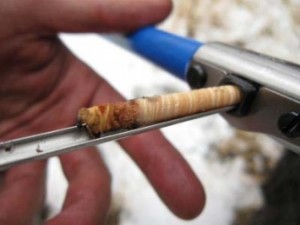By Penny Paugh
Trees grow on every continent except Antarctica, and the rings they contain embody a record of climate change going back thousands of years. Each ring represents a single year’s growth, so not only can a ring count tell us how old a tree is, but they can also help reconstruct climatic history around the world. A giant sequoia might have upward of 3,000 rings, and a bristlecone pine, found in the White Mountains of California, can approach 5,000.
Generally, tree rings’ variations in thickness indicate whether the tree had a good year in terms of favorable temperature and moisture or a bad one. The wood can vary in density from one year to the next as well, again, in response to seasonal weather changes. In regional studies, scientists take more than one sample from a single tree. Most trees are asymmetrical, so scientists can accurately determine the climatic history if samples are taken from several locations in the tree.
Scientists no longer chop down trees to take their samples. Their boring tool drills a small hole in the tree and draws out a cylinder of wood. The cylinders are then glued into grooves, machined into strips, dried, and finally put under a microscope, where the divisions between rings — just one layer of cells thick in some cases — are easily visible. The goal is to find patterns of wider and narrower rings that appear from one tree to the next, along with patterns of density changes. The patterns of rings inform scientists that the tree experienced climatic changes, but doesn’t tell if it was due to variations in temperature or moisture or both. To narrow the probability of error, researchers place modern instruments on trees showing recent changes where the weather is known, and then these changes are compared to historic data collections. Tree samples must be of the same types of trees.
In 2004, the Tree Ring Lab published its North American Drought Atlas, a sample regional study that showed evidence of several megadroughts that parched the continent over the past millennium. Another major study, this time of the Asian Monsoon, suggested that the fall of Angkor, in what is now Cambodia, came partly as a result of megadroughts. Studies are being conducted in Europe to create an Old World Drought Atlas, and tree rings are providing a large portion of the data.
Reference
Lemonick, M.D., (May 3, 2012) “Timelines in Timber: Inside a Tree-Ring Laboratory.” Climate Central retrieved from: http://www.climatecentral.org/news/timelines-in-timber-inside-a-tree-ring-laboratory/


Comments are closed.